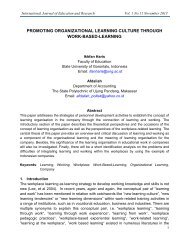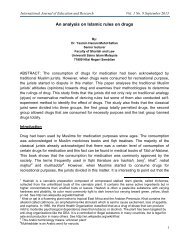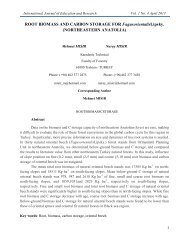A Special Case of Pathetic Fallacy: Papini's Picasso - International ...
A Special Case of Pathetic Fallacy: Papini's Picasso - International ...
A Special Case of Pathetic Fallacy: Papini's Picasso - International ...
Create successful ePaper yourself
Turn your PDF publications into a flip-book with our unique Google optimized e-Paper software.
ISSN: 2201-6333 (Print) ISSN: 2201-6740 (Online)<br />
www.ijern.com<br />
idea that persons continue to exist despite them being alive or dead.<br />
More than this, it gives us a point <strong>of</strong> departure in understanding Greer's article which brings<br />
in discussion the case <strong>of</strong> Pierre le Guennec who said that he is the proud and honest owner <strong>of</strong> 271<br />
works <strong>of</strong> <strong>Picasso</strong>, unknown to the public or even to the artist's heirs, his family, until the retired<br />
French electrician decided in 2010 to show them to Claude <strong>Picasso</strong>, the artist's son, in order to be<br />
authenticated (Greer, December 12, 2010). What is the liaison between the appearance <strong>of</strong> such an<br />
amount <strong>of</strong> new, or better said, not known until now, works <strong>of</strong> <strong>Picasso</strong>, “painted during his most<br />
creative period and worth a conservative estimate <strong>of</strong> €60m (£50.5m)” (Willsher, November 29,<br />
2010) and the quote from Papini, attributed once again by Germaine Greer to <strong>Picasso</strong>? She does not<br />
mention it clearly in her article, but Alfred Gell, speaking <strong>of</strong> the Malangan idols, provides us with<br />
an answer:<br />
The example <strong>of</strong> the Malangan art is useful in that it can start to undermine the distinction we<br />
commonly make between the material and the mental (or cognitive) with respect to material<br />
culture. The Malangan are indisputably material objects, but the socially relevant Malangan<br />
are internalized images which New Irelanders carry about inside their heads.(Gell, 1998, p.<br />
225)<br />
Taking this as a model we can equally state that is not an incoherent action to near, inside an<br />
article, two types <strong>of</strong> artifacts, one being a socially relevant image <strong>of</strong> an artist, appropriated and<br />
reconstructed by others, the other being material objects, works <strong>of</strong> art by the same artists, which<br />
surely exert some kind <strong>of</strong> agency over those who have them in their possession. If, in case <strong>of</strong> the<br />
Malangan, the social agency <strong>of</strong> the carved idols is exerted through remembrance, thus through an<br />
internalized image <strong>of</strong> that artifact, in the western society, the agency <strong>of</strong> the material artifact is<br />
efficient in its economical valuation, which depends, even if only partially, on the social agency<br />
exerted through internalized images that people have <strong>of</strong> the artist that shaped it.<br />
As coherent as it may be, this approximation was not necessary consciously done by<br />
Germaine Greer, not in the way we propose it, that being the reason why our attempt <strong>of</strong><br />
understanding is nothing else than an attempt <strong>of</strong> dressing her, through the mediation <strong>of</strong> Gell's<br />
theory, in an image which stems out our own mind.<br />
6. Conclusions<br />
The concept <strong>of</strong> pathetic fallacy was not <strong>of</strong> our use in any <strong>of</strong> the literary examples Ruskin<br />
provides for proving it, but in the reasons he gives for the occurrence <strong>of</strong> this falseness in seeing.<br />
Trying to understand how his aesthetic criterion is based on some perceptual ability <strong>of</strong> men, we<br />
discovered that this perceptual ability depends on a weakness <strong>of</strong> the soul, real or just represented.<br />
Therefore the presence <strong>of</strong> pathetic fallacy could be speculated for a certain intellectual if not even<br />
moral validation <strong>of</strong> the one in whose work it appears.<br />
This case study was not about how great an artist Pablo <strong>Picasso</strong> was, but about people using<br />
other people images for or against those people interest. The quote from <strong>Papini's</strong> Visita a <strong>Picasso</strong><br />
(Papini, 1952, pp. 265-268) was employed by some in order to discredit the Spanish artist as a<br />
moral person, which in fact has nothing to do with him as an artist, since art and morality do not<br />
10





